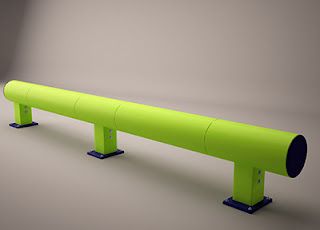Polymer barriers for warehouses and factories
Polymer bumper barriers provide valuable protection in warehouses and factories, particularly for forklift accident prevention and rack protection. Here are some key benefits of using polymer bumper barriers in these settings:
1. Forklift Accident Protection: Forklifts are commonly used in warehouses and factories for material handling tasks. However, accidents involving forklifts can lead to injuries, damage to equipment, and disruption of operations. Polymer bumper barriers act as a protective barrier between forklifts and personnel or equipment, reducing the risk of collisions and minimizing the impact force. They absorb and dissipate energy upon impact, helping to prevent accidents and mitigate the potential damage caused by forklift collisions.
2. Rack Protection: Warehouses often have racks and shelving systems for storing goods and materials. Accidental collisions with these racks can cause structural damage, leading to inventory losses and unsafe working conditions. Polymer bumper barriers can be installed at the end of racks and shelving aisles to act as a buffer, absorbing impact energy and protecting the racks from damage. This helps maintain the structural integrity of the storage system and reduces the need for frequent repairs or replacements.
3. Impact Absorption: Polymer bumper barriers are designed to absorb impact energy during collisions. They are typically made of resilient materials that can withstand repeated impacts without losing their effectiveness. The flexibility of the polymer allows it to absorb and distribute the force of the impact, preventing it from transferring to the protected structure or personnel. This absorption capability helps minimize damage to equipment, walls, columns, and other structural elements in warehouses and factories.
4. Visibility and Safety: Polymer bumper barriers can be made in bright colors or with reflective markings, enhancing visibility in the workspace. This increased visibility helps improve safety by alerting forklift operators and pedestrians to the presence of potential hazards or restricted areas. By clearly defining pathways, work zones, and storage areas, polymer bumper barriers contribute to a safer working environment, reducing the risk of accidents and injuries.
5. Easy Installation and Maintenance: Polymer bumper barriers are relatively easy to install and can be customized to fit specific warehouse or factory requirements. They can be mounted on walls, columns, or floor anchors, and can be easily adjusted or replaced as needed. Maintenance is generally minimal, as polymer bumper barriers are resistant to corrosion, moisture, and chemicals commonly found in industrial environments.
6. Cost-Effective Solution: Investing in polymer bumper barriers is a cost-effective solution compared to the potential costs associated with forklift accidents, equipment damage, and workplace injuries. By reducing the frequency and severity of accidents, these barriers help minimize downtime, repair expenses, and insurance claims. They contribute to overall cost savings and improve the efficiency of warehouse and factory operations.
Polymer bumper barriers offer several advantages over metal barriers in warehouses and factories for forklift accident protection and rack protection. Here is a comparison highlighting the benefits of using polymer bumper barriers over metal barriers:
1. Impact Absorption: Polymer bumper barriers excel in absorbing impact energy during collisions. Unlike metal barriers that tend to transfer the force of the impact, polymer barriers are designed to flex and absorb the energy, reducing the risk of damage to the forklift, personnel, and surrounding structures. This feature helps minimize the extent of the impact and lowers the potential for injuries and equipment damage.
2. Flexibility and Resilience: Polymer bumper barriers are made from flexible materials like PVC, allowing them to withstand repeated impacts without losing their effectiveness. In contrast, metal barriers may dent or deform upon impact, reducing their ability to provide consistent protection over time. The resilience of polymer barriers ensures they retain their shape and functionality, offering reliable and long-lasting protection.
3. Corrosion Resistance: Warehouses and factories are often exposed to moisture, chemicals, and other corrosive substances. Metal barriers are susceptible to corrosion over time, which compromises their structural integrity and effectiveness. Polymer bumper barriers, on the other hand, are highly resistant to corrosion, making them ideal for industrial environments. Their durability ensures continued protection even in harsh conditions.
4. Ease of Installation and Maintenance: Polymer bumper barriers are lightweight and easy to install, requiring minimal effort and resources. They can be mounted on walls, columns, or floor anchors, and can be customized to fit specific requirements. In contrast, metal barriers can be heavy and more challenging to install. Maintenance of polymer barriers is typically minimal, as they do not rust or require regular painting like metal barriers.
5. Cost-Effectiveness: Polymer bumper barriers offer a cost-effective solution compared to metal barriers. While the upfront cost of metal barriers may be lower, the long-term costs can be higher due to maintenance and repair expenses. Polymer barriers require less maintenance and are more resistant to damage, resulting in reduced downtime and repair costs. Additionally, polymer barriers' impact absorption properties help prevent costly damage to equipment and structures, resulting in overall cost savings.
6. Enhanced Safety Features: Polymer bumper barriers can be manufactured in bright colors or with reflective markings, enhancing visibility in the workspace. This increased visibility helps improve safety by alerting forklift operators and pedestrians to potential hazards or restricted areas. Metal barriers, in comparison, may not offer the same level of visibility enhancement, increasing the risk of accidents.
In conclusion, polymer bumper barriers offer numerous benefits over metal barriers in the context of forklift accident protection and rack protection in warehouses and factories. Their superior impact absorption, flexibility, corrosion resistance, ease of installation and maintenance, cost-effectiveness, and enhanced safety features make them a preferred choice. By choosing polymer bumper barriers, businesses can ensure efficient protection, reduce the risk of accidents and injuries, and promote a safe and productive working environment.
bumper barriers for warehouses (youtube.com)
Enquiries please contact tom@caldofreddo.me or call ±971 52 5060 253



Comments
Post a Comment